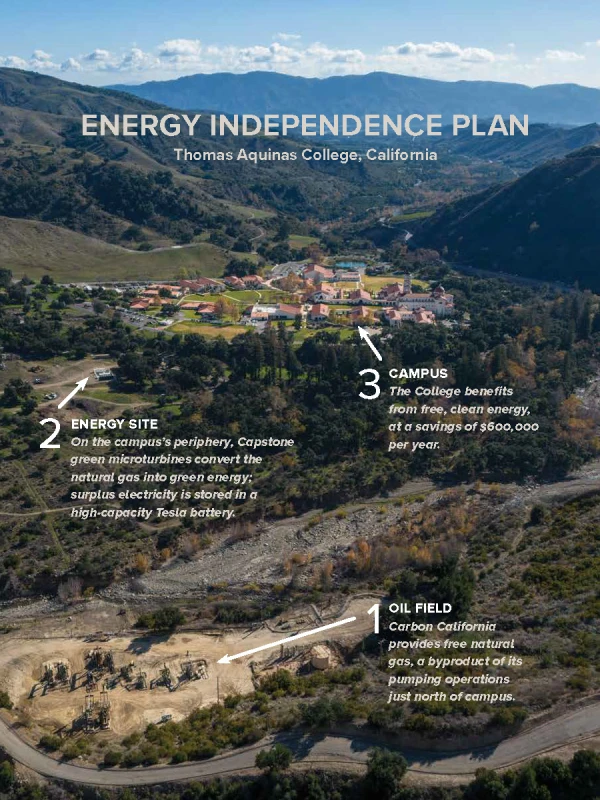CNA Staff, May 16, 2024 / 15:24 pm
A sequestered Catholic college in the foothills of California launched an energy program that has nearly eliminated the college’s carbon footprint while saving $600,000 a year, giving the school more reliable energy than the state power grid.
Thomas Aquinas College (TAC), a campus of more than 500 students, sits northwest of Los Angeles but offers something very different than the bustle and traffic of city life. Sitting on 845 acres, TAC’s discussion-based model of education is designed for a small, tight-knit community of students and “tutors,” who gather for class around round tables rather than desks.
“We are in the business of analytical thinking, of asking questions, of learning from and working with nature,” President Paul O’Reilly said of TAC in a May 7 press release. “And as a Catholic institution, we are very much in the business of shepherding our resources responsibly, partnering with our neighbors, and being good stewards of creation. Our new energy independence program reflects all these qualities.”

After a wildfire encircled the California campus in 2017, TAC’s energy was forever altered. High winds had sparked a fire from a high-voltage power line, turning a spark into one of the worst fires in California state history.
Since the disaster, the state took precautions by cutting power whenever there were high winds, resulting in routine campus blackouts, while utility costs only increased.
Determined to avoid two acres of solar fields on campus, Senior Tutor Thomas Kaiser, a biologist and researcher, knew that solar panels would “despoil the campus,” but he thought he could work with the campus’ neighbor — an oil and gas field company.
Working with electrical engineer and Brompton Energy Director Lawerence Youngblood, the two determined that a contract for free natural gas would be “a very economical decision.”
The neighboring company, Carbon California, agreed to the proposal.
“We knew that providing the natural gas to TAC, free of charge, was the only way for the system to be economically feasible,” said Jane Farkas, Carbon California’s vice president of land and regulatory affairs. “And we wanted to be a good neighbor.”
Together, they found a way to reduce Carbon California’s flaring and generate efficient and green energy for the campus.
“We have a gas stream that comes out of the wells near the campus, and we’ve allowed the college to tap into that line,” Scott Price, president of Carbon California, said in the press release.
The college installed the Capstone turbine on the lower campus and adjusted the electrical infrastructure of the upper campus during last summer and the beginning of the fall.
“We had never done anything like this before,” Mark Kretschmer, TAC vice president for operations, said in the press release. “There’s no way we could have completed this project, let alone so quickly, were it not for the countless hours of technical support and manpower that Carbon California provided throughout the installation, and which it continues to provide as we work through all the engineering and technical challenges.”

While the high-capacity Tesla battery used in the project was obtained for free through a state government program, the turbine installation cost $4.5 million. But according to the college, the project will pay for itself within six years due to tax incentives and energy savings.
(Story continues below)
“According to the Air Quality Management District, the Capstone turbine uses the most recent, best available control technology on the market,” Youngblood said. “Rather than flaring at high emissions, we can burn gas using that turbine’s efficient combustion technology at much lower emissions.”
“This energy-management plan and technology portfolio will put the college on such a high level that it will lead other universities throughout the United States,” Youngblood added.
Youngblood hopes to develop a similar system at TAC’s recently established New England campus.
“Why can’t TAC — which leads the way in Catholic liberal education — not also be the leader in implementing green technology as good stewards of God’s creation?” he noted.
“While the college is not in the business of technological innovation, this sort of innovation flows naturally from what we do,” O’Reilly added.






